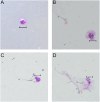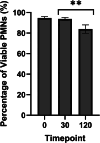Seminal plasma protects frozen-thawed ram spermatozoa from neutrophil attack: a complement mediated dynamic
- PMID: 40536802
- PMCID: PMC12231180
- DOI: 10.1530/REP-24-0465
Seminal plasma protects frozen-thawed ram spermatozoa from neutrophil attack: a complement mediated dynamic
Abstract
In brief: Frozen-thawed ram spermatozoa show reduced fertility following cervical artificial insemination, likely attributed to an elevated immune response in the ewe. This paper identifies the immunoprotective effect of ram seminal plasma (SP) against polymorphonuclear neutrophil binding, highlighting potential for fertility improvement.
Abstract: Following cervical artificial insemination, frozen-thawed (FT) ram spermatozoa display reduced fertility compared to fresh spermatozoa, irrespective of sperm motility and viability, likely attributed to an elevated immune response in the ovine cervix. SP has previously been shown to be beneficial to sperm transport in the ovine cervix, yet the components responsible for this protective effect remain unknown. As such, the present study examined the immune dynamics of frozen-thawed ram spermatozoa with polymorphonuclear neutrophils (PMNs), utilising a neutrophil binding assay. The effect of 25% v/v SP supplementation on binding susceptibility was also investigated. A portion of SP was heat-treated before incubation (HTSP) to isolate the impact of SP proteins. The presence of SP significantly reduced sperm-PMN binding (37.15 ± 0.02%, 46.59 ± 0.02%, 38.83 ± 0.02%) compared to FT alone (62.83 ± 0.02%, 75.74 ± 0.02%, 56.0 ± 0.03%) across all serum groups (no serum, serum and heat-treated serum, respectively). HTSP showed comparable binding susceptibility to the FT treatments, indicating that the protective effect of SP is attributed to a heat-labile factor. Serum significantly increased sperm-neutrophil binding irrespective of SP treatment. However, this was reduced to serum-free levels following heat-treatment, suggesting sperm-neutrophil dynamics are further mediated by protein components within ewe serum, likely complement proteins. The viability of sperm or the presence of freezing medium did not influence PMN binding. Furthermore, PMN viability and therefore binding were not influenced by the presence of serum or SP. Together, the current study presents new evidence for the immunoprotective properties of SP in sheep, which could be leveraged to aid transit through the cervix.
Keywords: cervical AI; cryopreservation; immune; sheep.
Conflict of interest statement
The authors declare that there is no conflict of interest that could be perceived as prejudicing the impartiality of the work reported.
Figures





Similar articles
-
Ram Semen Response to Cryopreservation With Extender Subjected to Ultrasonic Vibration and Myo-Inositol Enrichment.Reprod Domest Anim. 2025 Jul;60(7):e70091. doi: 10.1111/rda.70091. Reprod Domest Anim. 2025. PMID: 40686472
-
Implementation of high-resolution sperm respirometry for modeling bull fertility.J Anim Sci. 2025 Jan 4;103:skaf209. doi: 10.1093/jas/skaf209. J Anim Sci. 2025. PMID: 40518747
-
Incubation of semen with human follicular fluid improves the antioxidant status and quality of spermatozoa after freezing-thawing.Reprod Fertil. 2025 Jun 26;6(2):e240056. doi: 10.1530/RAF-24-0056. Print 2025 Apr 1. Reprod Fertil. 2025. PMID: 40460191 Free PMC article.
-
The Black Book of Psychotropic Dosing and Monitoring.Psychopharmacol Bull. 2024 Jul 8;54(3):8-59. Psychopharmacol Bull. 2024. PMID: 38993656 Free PMC article. Review.
-
[Volume and health outcomes: evidence from systematic reviews and from evaluation of Italian hospital data].Epidemiol Prev. 2013 Mar-Jun;37(2-3 Suppl 2):1-100. Epidemiol Prev. 2013. PMID: 23851286 Italian.
References
MeSH terms
Substances
LinkOut - more resources
Full Text Sources
Research Materials

